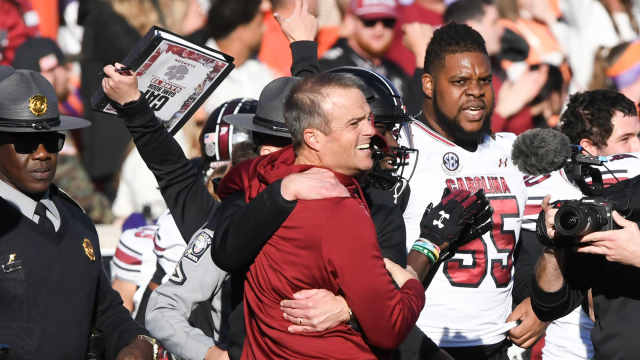South Carolina’s announcement that it will distribute $20.5 million directly to its student-athletes in the coming year marks a landmark moment in the evolution of college athletics and the way student-athletes are compensated. This substantial investment reflects a growing trend among collegiate programs nationwide to acknowledge the value and contribution of student-athletes beyond traditional scholarships and stipends. By allocating such a significant sum directly to its athletes, South Carolina is positioning itself at the forefront of this changing landscape, providing both tangible benefits to its players and signaling a commitment to remain competitive in recruiting and athlete support.
The $20.5 million distribution to student-athletes encompasses a range of avenues through which players can monetize their name, image, and likeness (NIL), as well as other forms of financial compensation that have emerged following recent changes in NCAA rules and state legislation. These funds represent not only a direct financial boost to the student-athletes but also an acknowledgment of the vital role they play in the university’s athletic success and brand development.
Historically, college athletes were limited to scholarships and minimal stipends, with strict rules prohibiting additional compensation. However, the landscape shifted dramatically in recent years, especially following the NCAA’s adoption of interim NIL policies and subsequent legal and legislative developments across various states. These changes allow student-athletes to profit from endorsements, personal appearances, social media, autograph signings, and other commercial opportunities tied to their personal brand. South Carolina’s sizeable financial commitment reflects an understanding of this new reality and a proactive approach to supporting its athletes.
The distribution of $20.5 million this year will cover a broad spectrum of student-athletes across multiple sports programs, from football and basketball to Olympic sports and other varsity teams. Football and men’s basketball players, typically the highest-profile athletes on campus, are expected to receive significant shares, reflecting their outsized role in generating revenue and media attention. However, the funds will also help support athletes in less visible sports, providing a more equitable financial benefit across the board. This inclusive approach strengthens the overall athletic department and fosters a culture of respect and value for all student-athletes.
South Carolina’s decision also serves as a strategic move in the highly competitive world of collegiate recruiting. With NIL deals becoming an increasingly important factor for recruits and their families, the ability to offer substantial financial opportunities is a powerful tool. Prospective athletes now consider not only the quality of the program and coaching staff but also the potential for personal brand growth and earnings during their collegiate careers. South Carolina’s commitment to facilitating significant NIL opportunities can help attract top-tier talent, leveling the playing field against traditional powerhouse programs.
Beyond recruiting, this financial commitment can also positively impact player retention and morale. Student-athletes who receive direct financial benefits may feel more valued and supported, contributing to stronger loyalty and engagement with the program. This can translate into better on-field performance, greater academic focus, and reduced transfer rates. For many athletes, the additional income helps alleviate financial pressures, allowing them to dedicate more energy to training and competition.
The administration at South Carolina, including the athletic department leadership and university officials, have worked diligently to create a framework that ensures these funds are distributed fairly, transparently, and in compliance with all relevant regulations. This involves close coordination with compliance officers, legal counsel, and external partners who specialize in NIL marketing and athlete representation. The goal is to maximize opportunities for athletes while maintaining the integrity of the program and adherence to NCAA guidelines.
South Carolina’s approach includes providing educational resources and support systems for athletes to navigate the complexities of NIL deals and financial management. Understanding contracts, taxes, and brand building are critical skills for student-athletes entering this new era of compensation. The university’s commitment to athlete education is designed to empower players to make informed decisions and protect their interests.
Comparatively, South Carolina’s $20.5 million distribution places it among the most generous programs nationally, signaling its ambition to compete not only on the field but also in the NIL marketplace. While some programs have announced similar or even larger NIL pools, South Carolina’s strategy is notable for its scale, inclusivity, and structured support. This positions the Gamecocks to be attractive to recruits who prioritize both athletic development and financial opportunity.
The broader implications of South Carolina’s NIL distribution extend beyond the university itself. It reflects a growing recognition across college athletics that student-athletes deserve compensation commensurate with their contribution to the sport and university revenue. This shift challenges traditional notions of amateurism and is part of a broader movement toward athlete empowerment and rights. As more schools adopt similar policies, the entire collegiate sports ecosystem is evolving to better serve the interests of athletes.
Critics of NIL compensation argue that it risks introducing inequalities and distractions within teams and could complicate the amateur status of college sports. However, South Carolina’s carefully structured program aims to mitigate these concerns by promoting fairness and education. By fostering an environment where athletes can pursue NIL opportunities responsibly, the university is helping set a standard for ethical and effective athlete compensation.
Financially, the $20.5 million commitment represents a significant investment from South Carolina’s athletic department budget and related revenue streams. The funding is derived from a combination of sources, including sponsorship deals, licensing agreements, booster contributions, and revenue generated by high-profile programs. This financial backing underscores the university’s confidence in the value of its athletic programs and its commitment to reinvesting in student-athletes.
The economic impact of such a distribution also extends to the local community. As athletes grow their personal brands and engage in endorsements or partnerships with local businesses, the economic ripple effect benefits the region. Increased visibility and success of South Carolina’s teams can boost tourism, merchandise sales, and community engagement, reinforcing the symbiotic relationship between the university and its surrounding environment.
South Carolina’s approach to NIL and athlete compensation also serves as a model for other institutions navigating this new landscape. By prioritizing transparency, fairness, education, and inclusivity, the program demonstrates how universities can support their athletes financially while maintaining program integrity. This leadership role enhances South Carolina’s reputation within collegiate athletics.
In terms of future outlook, the $20.5 million distribution is likely just the beginning of evolving compensation models for student-athletes at South Carolina and nationwide. As NIL markets mature and regulatory frameworks solidify, universities may explore additional ways to support their athletes financially. These could include enhanced stipends, direct payments tied to academic performance or community service, and expanded endorsement opportunities facilitated by university partnerships.
For South Carolina student-athletes, this financial support translates into real-world benefits. Many athletes will be able to cover living expenses, pay for personal training, invest in nutrition and recovery, and even save for life after college. This holistic support enhances their ability to perform at a high level and pursue professional careers if desired.
The cultural impact of this shift within South Carolina’s athletic community cannot be overstated. Athletes are empowered not only on the field but also in their personal and professional development. The visibility of player stories and successes in NIL ventures contributes to a vibrant, engaged fan base and a more connected university community.
From the perspective of coaches and staff, the ability to offer substantial NIL opportunities becomes a critical component of recruiting pitches. It complements traditional selling points such as facilities, academic programs, and competitive success. South Carolina’s proactive stance strengthens its position when competing for elite talent against other top-tier programs.
The commitment to distributing $20.5 million directly to student-athletes also encourages innovation within the athletic department. Marketing teams, compliance officers, and support staff are collaborating to create effective NIL platforms and opportunities. These efforts may include partnerships with brands, social media marketing support, and NIL-specific events that spotlight athletes’ talents and stories.
Looking ahead, South Carolina’s model may influence NCAA policy discussions and state legislation related to athlete compensation. As universities continue to develop best practices, the experiences of programs like South Carolina provide valuable insights into balancing athlete empowerment with program sustainability.
The success of South Carolina’s NIL program will also be measured by how well it helps athletes transition from college to professional sports or other careers. The skills and financial literacy developed through NIL opportunities can provide lifelong benefits, positioning athletes for success beyond their playing days.
In conclusion, South Carolina’s decision to distribute $20.5 million directly to student-athletes this year represents a bold and progressive step in collegiate athletics. It acknowledges the evolving realities of the sport, values the contributions of student-athletes, and provides substantial financial benefits that can enhance athletic and personal development. This investment not only strengthens South Carolina’s position in recruiting and competition but also serves as a blueprint for responsible, fair, and effective athlete compensation in the modern era of college sports. As this initiative unfolds, it will be closely watched by the collegiate sports community, setting a precedent that could shape the future of athlete compensation nationwide.



